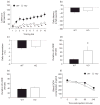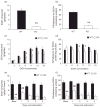A novel role for PSD-95 in mediating ethanol intoxication, drinking and place preference
- PMID: 21309945
- PMCID: PMC3150485
- DOI: 10.1111/j.1369-1600.2010.00282.x
A novel role for PSD-95 in mediating ethanol intoxication, drinking and place preference
Abstract
The synaptic signaling mechanisms mediating the behavioral effects of ethanol (EtOH) remain poorly understood. Post-synaptic density 95 (PSD-95, SAP-90, Dlg4) is a key orchestrator of N-methyl-D-aspartate receptors (NMDAR) and glutamatergic synapses, which are known to be major sites of EtOH's behavioral actions. However, the potential contribution of PSD-95 to EtOH-related behaviors has not been established. Here, we evaluated knockout (KO) mice lacking PSD-95 for multiple measures of sensitivity to the acute intoxicating effects of EtOH (ataxia, hypothermia, sedation/hypnosis), EtOH drinking under conditions of free access and following deprivation, acquisition and long-term retention of EtOH conditioned place preference (CPP) (and lithium chloride-induced conditioned taste aversion), and intoxication-potentiating responses to NMDAR antagonism. PSD-95 KO exhibited increased sensitivity to the sedative/hypnotic, but not ataxic or hypothermic, effects of acute EtOH relative to wild-type controls (WT). PSD-95 KO consumed less EtOH than WT, particularly at higher EtOH concentrations, although increases in KO drinking could be induced by concentration-fading and deprivation. PSD-95 KO showed normal EtOH CPP 1 day after conditioning, but showed significant aversion 2 weeks later. Lithium chloride-induced taste aversion was impaired in PSD-95 KO at both time points. Finally, the EtOH-potentiating effects of the NMDAR antagonist MK-801 were intact in PSD-95 KO at the dose tested. These data reveal a major, novel role for PSD-95 in mediating EtOH behaviors, and add to growing evidence that PSD-95 is a key mediator of the effects of multiple abused drugs.
© 2011 Society for the Study of Addiction. No claim to original US government works.
Figures





References
-
- Boyce-Rustay JM, Cameron HA, Holmes A. Chronic swim stress alters sensitivity to acute behavioral effects of ethanol in mice. Physiol Behav. 2007;91:77–86. - PubMed
-
- Boyce-Rustay JM, Holmes A. Functional roles of NMDA receptor NR2A and NR2B subunits in the acute intoxicating effects of ethanol in mice. Synapse. 2005;56:222–225. - PubMed
-
- Boyce-Rustay JM, Holmes A. Ethanol-related behaviors in mice lacking the NMDA receptor NR2A subunit. Psychopharmacology (Berl) 2006;187:455–466. - PubMed
-
- Boyce-Rustay JM, Wiedholz LM, Millstein RA, Carroll J, Murphy DL, Daws LC, Holmes A. Ethanol-related behaviors in serotonin transporter knockout mice. Alcohol Clin Exp Res. 2006;30:1957–1965. - PubMed
Publication types
MeSH terms
Substances
Grants and funding
LinkOut - more resources
Full Text Sources
Medical
Molecular Biology Databases
Research Materials
Miscellaneous

